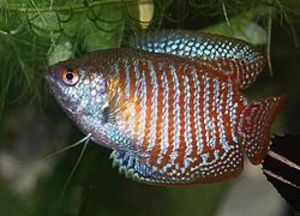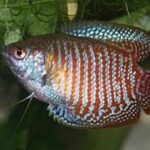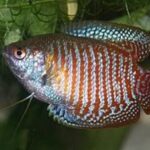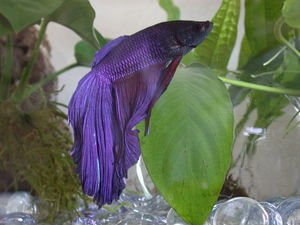If you are looking for a tropical freshwater fish that is beautiful, interesting to watch and easy to take care of, look no further than a gourami. The only gourami species to hit the pet trade that are too difficult for novice fishkeepers are chocolate gouramis (Sphaerichthys osphromenoides.)
Gouramis are in the same family as bettas (Siamese fighting fish), but are generally a lot more sociable (although not with bettas). There are many varieties that make up gouramis, but almost all of them have two thin antennae-like fins that poke into the gravel or substrata for food.
Origins And Family
Gouramis originated in various places in Asia. The main parent stock was nowhere near as glamorous as the creatures seen in pet shops and hobbyist’s tanks today. Just like with the betta, gouramis revealed scintillating colors and fin shapes during domestication. They like their water temperature tropical, about 72 to 82 degrees Farenheight.
Gouramis have been placed in a couple of fish families during scientific classification. Most of them are now in the hard to pronounce Osphronemidae family. There is some argument as to whether Kissing gouramis (also called kissing fish or (Helostoma temminckii)) are actually true gouramis. However, they look nearly identical to other gourami varieties, except for those Mick Jagger lips. Many hobbyists have also noted that they will often attack fish smaller than they are.
Take A Breath
One of the advantages of being a gourami is that you have an extra organ for breathing air instead instead of just being stuck breathing water. This is also a trait of Paradise fish and bettas. This organ is called the labyrinth organ. Although this helps a gourami survive water that contains low oxygen content, they should not be permanently kept in such poor water.
Mixed Company
Most gouramis in the pet trade only get to be a couple of inches long, which makes them suitable for community aquariums. Popular varieties include the dwarf gourami (Colisa lalia), the opaline or three-spot gourami ( Trichogaster trichopterus) and the moonlight or moonbeam gourami (Trichogaster microlepis.)
They eat just about any food suitable for tropical fish (even algae wafers) and so you don’t need to feed them any special food. It’s good to rotate a couple of commercially made foods to give them variety.
Keep only one variety of gourami in the tank as the varieties do not get along. Some gouramis are more aggressive than others. For every gourami that’s gotten along with a swordtail or molly, you’ll hear of another that mercilessly hounded a swordtail and a molly. Generally, gouramis get along with danios, tetras, small plecostomus and Chinese algae eaters. Gouramis usually do not get along with bettas and definitely not cichlids, including angelfish.
Have plenty of hiding places in your tank for smaller fish (or for the gourami) in case there are squabbles inside the tank. These can be thick artificial plants, rocks with small holes or tiny flowerpots. If you have a male and female gourami, then the hiding places will be greatly appreciated by the harassed female come spawning time.
References:
“Freshwater Aquariums for Dummies, 2nd Edition.” Maddy Hargrove & Mic Hargrove. Wiley Publishing; 2006.
Aqualand Fact Sheets. “How to Care for Chocolate Gouramis.” http://aqualandpetsplus.com/Gourami,%20Chocolate.htm
Pet Education. “Freshwater Gouramis.” http://www.peteducation.com/category.cfm?c=16+1911+1957
Personal experience






